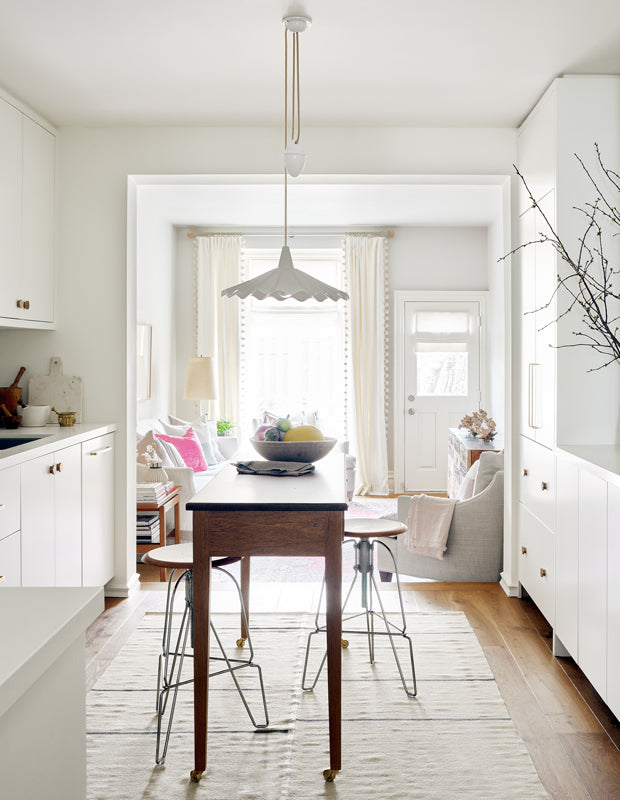
Why Ditching Your Kitchen Island for a Dining Table Might Be the Best Thing You Ever Do
There comes a time in every kitchen’s life when someone stands in the middle of it, staring at that big, blocky island and thinks: Do I really need you?
Friends, the answer might just be no.
If you’ve been dreaming of more warmth, better flow, and a bit less “everyone piles junk on the island” energy, replacing it with a beautiful dining table could be your kitchen’s glow-up moment. Here’s why — and how to do it right.

image credit: Pinterest
1. The Case Against the Island
Don’t get me wrong: islands have their place. They can house sinks, dishwashers, and that one cousin who never leaves the snack tray. But they’re also notorious clutter magnets and can swallow up precious floor space in all but the most palatial kitchens.
If your floorplan feels tight and your angling all your furniture to accommodate the island, you're the perfect candidate to ditch it completely Basically your island may be more hindrance than help.
2. Enter: The Dining Table
A table, on the other hand, invites connection. It says, Sit, stay awhile. It doesn’t demand matching counter stools or awkward lean-ins. It can be a homework zone, a wine-and-gossip headquarters, or the landing spot for fresh flowers and a big bowl of fruit.
A table is mobile, human-scale, and endlessly charming — three things a built-in island rarely is.

image credit; Emily Griffin
3. Space and Flow — Instantly Improved
Without that big box in the middle, watch how your kitchen breathes again. Traffic flows freely, multiple people can cook without elbow jousting, and your room feels twice as big without a single renovation.
Pro tip: If you’re worried about losing storage, consider a table with drawers or a vintage farm table with deep aprons. Or sneak in a slim sideboard nearby to handle the overflow.
4. How to Choose the Right Table
Now for the fun part: picking your new star player. A few quick guidelines:
Size: Leave at least 36 inches of clearance on all sides so people can pass comfortably, even with chairs pulled out.
Shape: Rectangular works in most kitchens, but a round table can be magic in a tight or square layout.
Style: You don’t have to match your cabinets. In fact, a table in a contrasting wood or a painted finish can add the layered, collected feel designers love.
Durability: Kitchens are rough on furniture. Choose a wipeable top — think sealed wood, stone, or even a well-loved antique that wears scratches gracefully.
5. Seating — Mix It Up
Just like a mismatched kitchen, a table setup loves a little mix. Pair a bench on one side (great for kids) with a few sturdy chairs on the other. Or go all chairs but mix styles for a curated, un-kitchen-y vibe.
Cushions or slipcovered seats add softness and a touch of je ne sais quoi to all that hard cabinetry.
6. Style It Beautifully
Tables beg to be dressed. A simple linen runner, a rotating display of fresh herbs, or a big bowl of lemons can make your new centerpiece feel intentional, not like you just dragged the dining set in from the garage.
Pro tip: a pendant light hung directly over the table anchors it beautifully and makes the swap feel polished and purposeful.

image credit: Andrew Montgomery
7. Practical Considerations
Still worried about prep space? Many people find they rarely used their island for true cooking prep anyway — more often it was a dumping ground for mail and cereal bowls.
A large, sturdy table can handle kneading dough and chopping veggies just fine. Or use a big cutting board you can whisk away at dinner time. Flexibility is the whole point!
image credit: pinterest
Final Thoughts
Replacing your kitchen island with a dining table is more than just a design choice — it’s a lifestyle upgrade. It prioritizes warmth over bulk, conversation over clutter, and style over sameness.
So, if your island is feeling more like a barricade than a bonus, maybe it’s time to trade it in for something with soul — and four legs.
Happy gathering!
-Juliette

